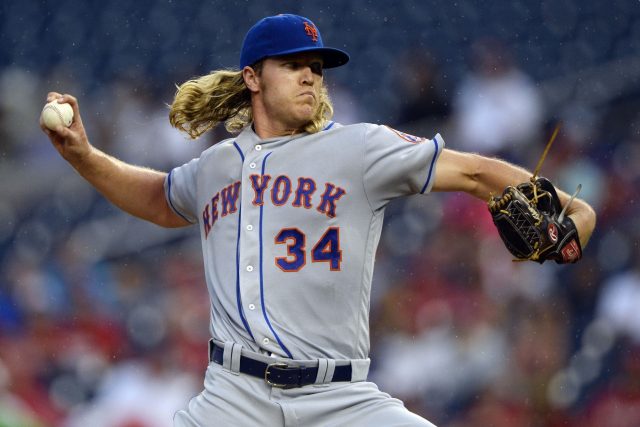It’s Time For The New York Mets To Talk About Innings Limits

The New York Mets are playing with fire in management – or lack thereof – of young arms’ innings.
Better be safe than sorry.
That’s an expression which has been largely ignored – or, at the minimum, too loosely practiced – by the management brass of the New York Mets.
The man responsible for the innings management of the team’s group of under-30-year-old starting pitchers (deGrom, Harvey, Matz, Syndergaard) is none other than Sandy Alderson, the same man who architected a roster which included all four in October baseball last season.
Alderson, though indisputably a bright, savvy baseball man, has played with fire in his approach toward protecting the quartet by prioritizing winning over caution for health.
SEE ALSO: Zack Wheeler Pitches An Inning In First Rehab Assignment
Sometimes it is impossible to ignore a correlation so apparent as the recent performance of Steven Matz and Noah Syndergaard. The lefty, 25, and right-hander, 23, each had his high point in 2016, with both pitchers commanding attention as rising stars of the game. Recent play, though, has unveiled two pitchers with the same dominant stuff while wading in poor results.
In Syndergaard, it seemed the Mets had found yet another emergence of an ace pitcher with the early results of a guy who played the part of a god on earth convincingly.
Over his first 13 starts, Syndergaard pitched to a pristine 2.00 ERA with 95 strikeouts and just 12 walks.
In his last seven, he’s been a different pitcher, sporting a win-loss record of 1-4 and a 3.99 ERA.
That tumble began in Washington on June 27, where Syndergaard pitched just three innings and surrendered five runs on seven hits and three walks in a 4-2 loss which completed the sweep for the division rival Nationals.
Not long after the game, reports surfaced indicating that Syndergaard had been pitching with a bone spur in his throwing elbow. After immediate denial, and eventual submission, Syndergaard insisted he was healthy and able to pitch despite the spur.
[sc name=”Mets Center 2″ ]Yet the results have been so different. The numbers are such an aberration from the Syndergaard who seemed unhittable, the Syndergaard who was so on-point that a walk was a rare occasion, and the Syndergaard who yielded ‘Oohs’ and ‘Ahs ‘with a triple-digit fastball coupled with a slider sitting at 92-94 miles per hour – that it seems appropriate to form the link.
Many would dismiss the link of diminished performance to pitching too many innings and through pain as purely speculative, but the context gives a basis for such doubt.
For some more context, it’s wise to look at his innings totals throughout the minors and compare them to his innings for 2015, in which he threw 198.2 innings between Las Vegas and the Mets.
From 2014’s 133 innings total at Las Vegas, Syndergaard jumped an unfathomable 65.2 innings pitched. Prior to his season and a half at Triple-A Vegas, he pitched 59, 103.2, and 117.2 innings in his first three professional seasons respectively.
Thus, last year tested uncharted waters for the physically imposing right-hander, then just 22 years of age.
For the part of Steven Matz, the narrative runs with similar peaks and bounds to that of his teammate. Since beginning the year with a 7-1 tear and a sharp 2.28 ERA, Matz has fallen into an abyss of league-average pitching, which is a mark he has never quite aligned with.
Since June 1, the southpaw is 1-6 with a 4.37 ERA. During the same road trip in Washington, reports indicated that Matz, too, was pitching through pain with a bone spur in his left elbow.
His was thought to be more severe than Syndergaard’s, and it seems to have affected his throwing arsenal and control. It should also be noted that Matz underwent Tommy John surgery on his left elbow in 2010, at just 18 years old.
With both Mets’ youngsters subjected to elbow discomfort and pain, results have been less consistent and, overall, alarming.
RELATED: Future Complications Posed By Jay Bruce’s Acquisition
And with Syndergaard at 130 innings pitched for 2016 and Matz having thrown just under 120, the Mets’ problem isn’t about to get easier. With consideration for the respective futures of these two promising hurlers, the Mets should not allow either to touch 220 innings.
To call Alderson careless or inconsiderate would be irresponsible because the veteran GM has displayed an impressive baseball awareness and has gained the respect of executives and baseball people across the sport.
It is fair, however, to criticize him for not addressing the young flamethrowers in the light of innings limits, skipped starts, and perhaps even a minimum 15-day DL stint – or three starts – so as to assure neither is overexerted by season’s end.
If measures aren’t taken by the Mets’ management, the team has effectively jeopardized the careers of two pitchers with ability to pitch like stars now, and potential to develop to another level in the future.
With that reality in mind, it would be shameful and irresponsible to overwork these kids.
So please Sandy, have some foresight – and use your displayed wit – to manage the situation with the same effectiveness with which you built a National League Championship team.
You’d better be safe than sorry.
NEXT: Mets Playoff Odds The Lowest They’ve Been All Year
"Either write something worth reading or do something worth writing."
-Benjamin Franklin






